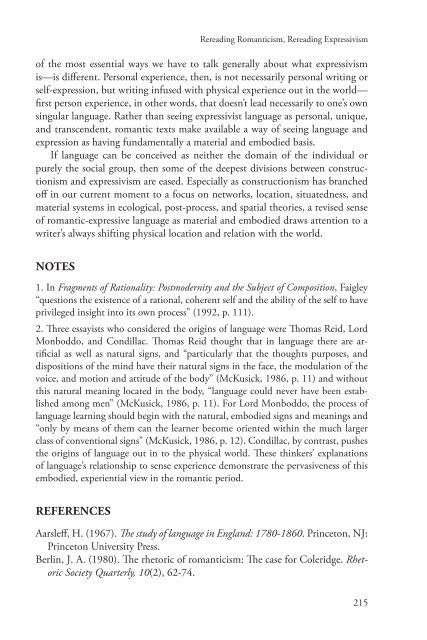Critical Expressivism- Theory and Practice in the Composition Classroom, 2014a
Critical Expressivism- Theory and Practice in the Composition Classroom, 2014a
Critical Expressivism- Theory and Practice in the Composition Classroom, 2014a
Create successful ePaper yourself
Turn your PDF publications into a flip-book with our unique Google optimized e-Paper software.
Reread<strong>in</strong>g Romanticism, Reread<strong>in</strong>g <strong>Expressivism</strong><br />
of <strong>the</strong> most essential ways we have to talk generally about what expressivism<br />
is—is different. Personal experience, <strong>the</strong>n, is not necessarily personal writ<strong>in</strong>g or<br />
self-expression, but writ<strong>in</strong>g <strong>in</strong>fused with physical experience out <strong>in</strong> <strong>the</strong> world—<br />
first person experience, <strong>in</strong> o<strong>the</strong>r words, that doesn’t lead necessarily to one’s own<br />
s<strong>in</strong>gular language. Ra<strong>the</strong>r than see<strong>in</strong>g expressivist language as personal, unique,<br />
<strong>and</strong> transcendent, romantic texts make available a way of see<strong>in</strong>g language <strong>and</strong><br />
expression as hav<strong>in</strong>g fundamentally a material <strong>and</strong> embodied basis.<br />
If language can be conceived as nei<strong>the</strong>r <strong>the</strong> doma<strong>in</strong> of <strong>the</strong> <strong>in</strong>dividual or<br />
purely <strong>the</strong> social group, <strong>the</strong>n some of <strong>the</strong> deepest divisions between constructionism<br />
<strong>and</strong> expressivism are eased. Especially as constructionism has branched<br />
off <strong>in</strong> our current moment to a focus on networks, location, situatedness, <strong>and</strong><br />
material systems <strong>in</strong> ecological, post-process, <strong>and</strong> spatial <strong>the</strong>ories, a revised sense<br />
of romantic-expressive language as material <strong>and</strong> embodied draws attention to a<br />
writer’s always shift<strong>in</strong>g physical location <strong>and</strong> relation with <strong>the</strong> world.<br />
NOTES<br />
1. In Fragments of Rationality: Postmodernity <strong>and</strong> <strong>the</strong> Subject of <strong>Composition</strong>, Faigley<br />
“questions <strong>the</strong> existence of a rational, coherent self <strong>and</strong> <strong>the</strong> ability of <strong>the</strong> self to have<br />
privileged <strong>in</strong>sight <strong>in</strong>to its own process” (1992, p. 111).<br />
2. Three essayists who considered <strong>the</strong> orig<strong>in</strong>s of language were Thomas Reid, Lord<br />
Monboddo, <strong>and</strong> Condillac. Thomas Reid thought that <strong>in</strong> language <strong>the</strong>re are artificial<br />
as well as natural signs, <strong>and</strong> “particularly that <strong>the</strong> thoughts purposes, <strong>and</strong><br />
dispositions of <strong>the</strong> m<strong>in</strong>d have <strong>the</strong>ir natural signs <strong>in</strong> <strong>the</strong> face, <strong>the</strong> modulation of <strong>the</strong><br />
voice, <strong>and</strong> motion <strong>and</strong> attitude of <strong>the</strong> body” (McKusick, 1986, p. 11) <strong>and</strong> without<br />
this natural mean<strong>in</strong>g located <strong>in</strong> <strong>the</strong> body, “language could never have been established<br />
among men” (McKusick, 1986, p. 11). For Lord Monboddo, <strong>the</strong> process of<br />
language learn<strong>in</strong>g should beg<strong>in</strong> with <strong>the</strong> natural, embodied signs <strong>and</strong> mean<strong>in</strong>gs <strong>and</strong><br />
“only by means of <strong>the</strong>m can <strong>the</strong> learner become oriented with<strong>in</strong> <strong>the</strong> much larger<br />
class of conventional signs” (McKusick, 1986, p. 12). Condillac, by contrast, pushes<br />
<strong>the</strong> orig<strong>in</strong>s of language out <strong>in</strong> to <strong>the</strong> physical world. These th<strong>in</strong>kers’ explanations<br />
of language’s relationship to sense experience demonstrate <strong>the</strong> pervasiveness of this<br />
embodied, experiential view <strong>in</strong> <strong>the</strong> romantic period.<br />
REFERENCES<br />
Aarsleff, H. (1967). The study of language <strong>in</strong> Engl<strong>and</strong>: 1780-1860. Pr<strong>in</strong>ceton, NJ:<br />
Pr<strong>in</strong>ceton University Press.<br />
Berl<strong>in</strong>, J. A. (1980). The rhetoric of romanticism: The case for Coleridge. Rhetoric<br />
Society Quarterly, 10(2), 62-74.<br />
215


















